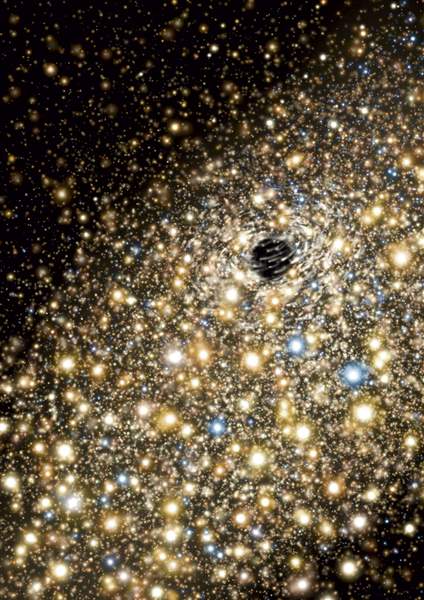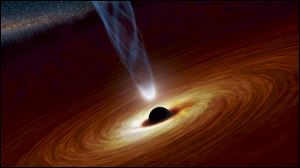
Black holes: It’s snack time in the cosmos
2/24/2014
In March or April, a gas cloud that has been hurtling toward the center of the Milky Way is expected to collide with Sagittarius A*, a black hole that lies just 26,000 light-years from Earth. (The actual event, of course, took place 26,000 years ago.)

In March or April, a gas cloud that has been hurtling toward the center of the Milky Way is expected to collide with Sagittarius A*, a black hole that lies just 26,000 light-years from Earth. (The actual event, of course, took place 26,000 years ago.)
Black holes, the ultradense collapsed objects predicted by Einstein’s theory of general relativity, are often depicted as voracious feeders whose extraordinary gravity acts like a one-way membrane: Everything is sucked in, even light, and virtually nothing leaks out.
Now, for the first time, astronomers may have a chance to watch as a giant black hole consumes a cosmic snack.
In March or April, a gas cloud that has been hurtling toward the center of the Milky Way is expected to collide with Sagittarius A*, a black hole that lies just 26,000 light-years from Earth. (The actual event, of course, took place 26,000 years ago.)
The cloud is as massive as three Earths — no match for the black hole, which has the mass of 4 million suns.
“This is a rare opportunity to witness spoon-feeding of a black hole,” said Avi Loeb, a theoretical astrophysicist at Harvard. “Will the gas reach the black hole, and if so, how quickly? Will the black hole throw up or spit the gas out in the form of an outflow or a jet?
“The experience is as exciting for astronomers,” he went on, “as it is for parents taking the first photos of their infant eating.”
If the black hole devours a sizable chunk of the cloud, a digestive process that could take many months to years, fireworks could ensue. Heated to billions of degrees as it spirals inward, the doomed gas cloud may emit a last gasp of radiation, ranging from radio waves to X-rays.
But even if the encounter proves a dud, it may still provide insight about the feeding habits of big black holes, which are believed to reside at the center of nearly every large galaxy.
“We will learn something no matter what happens,” said Andrea Ghez, an astronomer at the University of California, Los Angeles, who has monitored the galactic center since 1995.
The action is likely to unfold in two acts, said Stefan Gillessen of the Max Planck Institute for Extraterrestrial Physics in Germany. His team discovered the gas cloud, G2, in 2011.
The first stage could come just weeks after the cloud, already stretched into a spaghettilike strand by the black hole’s gravity, makes its closest approach to Sagittarius A*. Models suggest that will occur around March 31, give or take three weeks, Gillessen said.

In March or April, a gas cloud that has been hurtling toward the center of the Milky Way is expected to collide with Sagittarius A*, a black hole that lies just 26,000 light-years from Earth. (The actual event, of course, took place 26,000 years ago.)
At closest approach, the cloud's distance from the black hole will still be about 200 times Earth's distance from the sun. Nonetheless, the passage might be near enough for G2 to plow into the outer edge of the swirling disk of matter believed to surround and feed the black hole.
The shock wave generated by that encounter may create X-rays and radio waves that could be detected by telescopes.
If the cloud contains a star at its center, as some astronomers have proposed, it may produce a stronger shock and generate more light, said Sera Markoff of the University of Amsterdam.
The encounter could have another effect: Disruptions in the cloud might alter the direction in which radio waves vibrate as they travel through.
Simultaneous observations with telescopes tuned to different radio wavelengths have a chance of discerning the waves' twists, giving astronomers new details about the cloud's properties, said Geoffrey Bower, a radio astronomer with ASIAA, the Taiwanese astronomy organization, in Hilo, Hawaii.
But most of the potential fireworks are at least a year away, perhaps decades. That is how long it may take material torn from G2 to spiral inward through the black hole's feeding disk, coming 100 times as close to the hole as it is now. At that location, gas becomes hot enough to radiate at high intensity before it is swallowed.
Moreover, astronomers think that if the gas cloud is to be swallowed, it will have to lose much of its angular momentum, or orbital rotation, around the black hole.
Although theorists have proposed that friction in the disk reduces the material's rotation, "the simulations on our computers are not capable enough to track the descent," Gillessen said.